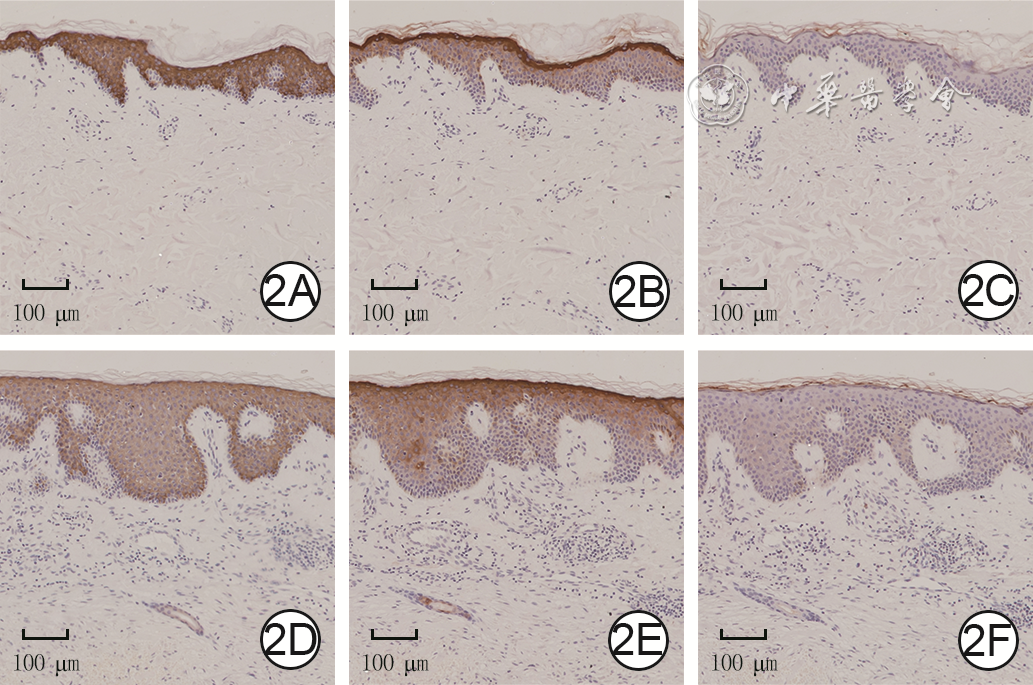| [1] |
TanS, KhumaloN, BayatA. Understanding keloid pathobiology from a quasi-neoplastic perspective: less of a scar and more of a chronic inflammatory disease with cancer-like tendencies[J]. Front Immunol,2019, 10:1810.DOI: 10.3389/fimmu.2019.01810.
|
| [2] |
AndrewsJP, MarttalaJ, MacarakE, et al. Keloids: the paradigm of skin fibrosis-pathomechanisms and treatment[J]. Matrix Biol,2016,51:37-46.DOI: 10.1016/j.matbio.2016.01.013.
|
| [3] |
OgawaR. Keloid and hypertrophic scars: are the result of chronic inflammation in the reticular dermis[J]. Int J Mol Sci,2017,18(3):606.DOI: 10.3390/ijms18030606.
|
| [4] |
LimandjajaGC, NiessenFB, ScheperRJ, et al. The keloid disorder: heterogeneity, histopathology, mechanisms and models[J]. Front Cell Dev Biol,2020,8:360.DOI: 10.3389/fcell.2020.00360.
|
| [5] |
TsaiCH, OgawaR. Keloid research: current status and future directions[J]. Scars Burn Heal, 2019,5:2059513119868659.DOI: 10.1177/2059513119868659.
|
| [6] |
UehaS, ShandFHW, MatsushimaK. Cellular and molecular mechanisms of chronic inflammation-associated organ fibrosis[J]. Front Immunol,2012,3:71.DOI: 10.3389/fimmu.2012.00071.
|
| [7] |
WangZC, ZhaoWY, CaoYY, et al. The roles of inflammation in keloid and hypertrophic scars[J]. Front Immunol,2020,11:603187.DOI: 10.3389/fimmu.2020.603187.
|
| [8] |
TandaraAA, MustoeTA. The role of the epidermis in the control of scarring:evidence for mechanism of action for silicone gel[J]. J Plast Reconstr Aesthet Surg,2008,61(10):1219-1225.DOI: 10.1016/j.bjps.2008.03.022.
|
| [9] |
MustoeTA. Evolution of silicone therapy and mechanism of action in scar management[J]. Aesthetic Plast Surg,2008,32(1):82-92.DOI: 10.1007/s00266-007-9030-9.
|
| [10] |
OgawaR, DohiT, TosaM, et al. The latest strategy for keloid and hypertrophic scar prevention and treatment: the Nippon Medical School (NMS) protocol[J]. J Nippon Med Sch,2021,88(1):2-9.DOI: 10.1272/jnms.JNMS.2021_88-106.
|
| [11] |
O'BrienL, JonesDJ. Silicone gel sheeting for preventing and treating hypertrophic and keloid scars[J]. Cochrane Database Syst Rev,2013,2013(9):CD003826.DOI: 10.1002/14651858.CD003826.pub3.
|
| [12] |
AlexanderH, BrownS, DanbyS, et al. Research techniques made simple: transepidermal water loss measurement as a research tool[J]. J Invest Dermatol,2018,138(11):2295-2300.e1.DOI: 10.1016/j.jid.2018.09.001.
|
| [13] |
DiniV, BarbaneraS, RomanelliM. Quantitative evaluation of maceration in venous leg ulcers by transepidermal water loss(TEWL) measurement[J]. Int J Low Extrem Wounds,2014,13(2):116-119.DOI: 10.1177/1534734614536035.
|
| [14] |
GardienKLM, BaasDC, de VetHCW, et al. Transepidermal water loss measured with the Tewameter TM300 in burn scars[J]. Burns,2016,42(7):1455-1462.DOI: 10.1016/j.burns.2016.04.018.
|
| [15] |
KuniiT, HiraoT, KikuchiK, et al. Stratum corneum lipid profile and maturation pattern of corneocytes in the outermost layer of fresh scars: the presence of immature corneocytes plays a much more important role in the barrier dysfunction than do changes in intercellular lipids[J]. Br J Dermatol,2003, 149(4):749-756.DOI: 10.1046/j.1365-2133.2003.05545.x.
|
| [16] |
EhrlichHP, DesmoulièreA, DiegelmannRF, et al. Morphological and immunochemical differences between keloid and hypertrophic scar[J]. Am J Pathol,1994,145(1):105-113.
|
| [17] |
BetarbetU, BlalockTW. Keloids: a review of etiology, prevention, and treatment[J]. J Clin Aesthet Dermatol,2020,13(2):33-43.
|
| [18] |
BaroniA, BuomminoE, De GregorioV, et al. Structure and function of the epidermis related to barrier properties[J]. Clin Dermatol,2012,30(3):257-262.DOI: 10.1016/j.clindermatol.211.08.007.
|
| [19] |
MenonGK, ClearyGW, LaneME. The structure and function of the stratum corneum[J]. Int J Pharm, 2012,435(1):3-9.DOI: 10.1016/j.ijpharm.2012.06.005.
|
| [20] |
RawlingsAV, HardingCR. Moisturization and skin barrier function[J]. Dermatol Ther,2004,17 (Suppl 1):S43-48.DOI: 10.1111/j.1396-0296.2004.04s1005.x.
|
| [21] |
SuetakeT, SasaiS, ZhenYX, et al. Functional analyses of the stratum corneum in scars. Sequential studies after injury and comparison among keloids, hypertrophic scars, and atrophic scars[J]. Arch Dermatol,1996,132(12):1453-1458.
|
| [22] |
LimandjajaGC, van den BroekLJ, WaaijmanT, et al. Increased epidermal thickness and abnormal epidermal differentiation in keloid scars[J]. Br J Dermatol,2017,176(1):116-126. DOI: 10.1111/bjd.14844.
|
| [23] |
OuseyK, CuttingKF, RogersAA, et al. The importance of hydration in wound healing: reinvigorating the clinical perspective[J]. J Wound Care,2016,25(3):122,124-130.DOI: 10.12968/jowc.2016.25.3.122.
|
| [24] |
SawadaY, SoneK. Hydration and occlusion treatment for hypertrophic scars and keloids[J]. Br J Plast Surg,1992,45(8):599-603.DOI: 10.1016/0007-1226(92)90027-u.
|
| [25] |
SuetakT, SasaiS, ZhenYX, et al. Effects of silicone gel sheet on the stratum corneum hydration[J]. Br J Plast Surg,2000,53(6):503-507.DOI: 10.1054/bjps.2000.3388.
|
| [26] |
KumarAS, KamalasananK. Drug delivery to optimize angiogenesis imbalance in keloid: a review[J]. J Control Release,2021,329:1066-1076.DOI: 10.1016/j.jconrel.2020.10.035.
|
| [27] |
MariW, AlsabriSG, TabalN, et al. Novel insights on understanding of keloid scar: article review[J]. J Am Coll Clin Wound Spec,2016,7(1/2/3):1-7.DOI: 10.1016/j.jccw.2016.10.001.
|
| [28] |
LeeHJ, JangYJ. Recent understandings of biology, prophylaxis and treatment strategies for hypertrophic scars and keloids[J]. Int J Mol Sci,2018,19(3):711.DOI: 10.3390/ijms19030711.
|
| [29] |
SogabeY, AkimotoS, AbeM, et al. Functions of the stratum corneum in systemic sclerosis as distinct from hypertrophic scar and keloid functions[J]. J Dermatol Sci,2002,29(1):49-53.DOI: 10.1016/s0923-1811(02)00006-3.
|
| [30] |
SandlandsA, SutherlandC, IrvineAD, et al. Filaggrin in the frontline: role in skin barrier function and disease[J]. J Cell Sci,2009,122(Pt 9):1285-1294.DOI: 10.1242/jcs.033969.
|
| [31] |
BrettmannEA, de Guzman StrongC. Recent evolution of the human skin barrier[J]. Exp Dermatol, 2018,27(8):859-866.DOI: 10.1111/exd.13689.
|
| [32] |
AnS, ChaHJ, KoJM, et al. Kinetin improves barrier function of the skin by modulating keratinocyte differentiation markers[J]. Ann Dermatol,2017,29(1):6-12.DOI: 10.5021/ad.2017.29.1.6.
|
| [33] |
VisscherMO, SaidD, WickettR. Stratum corneum cytokines, structural proteins, and transepidermal water loss: effect of hand hygiene[J]. Skin Res Technol,2010,16(2):229-236.DOI: 10.1111/j.1600-0846.2009.00411.x.
|
| [34] |
MollR, DivoM, LangbeinL. The human keratins: biology and pathology[J]. Histochem Cell Biol, 2008,129(6):705-733.DOI: 10.1007/s00418-008-0435-6.
|
| [35] |
JumperN, PausR, BayatA. Functional histopathology of keloid disease[J]. Histol Histopathol,2015, 30(9):1033-1057. DOI: 10.14670/HH-11-624.
|
| [36] |
LeeJYY, YangCC, ChaoSC, et al. Histopathological differential diagnosis of keloid and hypertrophic scar[J]. Am J Dermatopathol,2004,26(5): 379-384.DOI: 10.1097/00000372-200410000-00006.
|









 下载:
下载:

